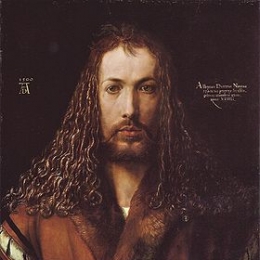Details
Reference: From the small woodcut passion - H.145
Edition without text on the backside after 1511
Woodcut . Full plate border and tread margins. Still good impression from the used block with some worm holes and broken borderline visible.
Read more about the Small Woocut Passion
Additional Information
| SKU | xxd35.1 |
|---|---|
| Picture Size | 12,70 cm x 10 cm |
| Specification | |
| technic | Woodcut |
| Artist | Albrecht Durer |
| period | before 1500 |
| School | German |
| subject | Religious |
| rating | **** |
Albrecht Durer (1471-1528) 
Son of a goldsmith who settled in Nuremberg in 1455, and in 1467 married his master's daughter. The young Albrecht was first apprenticed to his father, and was then bound for three years to the painter Michael Wolgemut, whose large workshop also produced woodcut book-illustrations for the printer Anton Koberger, Durer's godfather. He traveled for four years, from Easter 1490, visiting Colmar, Basle, and Strasbourg, and in May 1494 he returned to Nuremberg and married. In the autumn of 1494 he went to Venice. During this visit he met Giovanni Bellini, whom he greatly admired, and painted several works for the German merchants of Venice, which shows some knowledge of Leonardo. On his return he intensified the learned side of his art and personality; he studied mathematics, geometry, Latin, and humanist literature, and sought the company of scholars rather than that of his fellow artistisans. This departure in mode of life and thought was directly traceable to the influence of Leonardo and Mantegna and the example of Bellini, and though it was common enough in Italy, it was unprecedented in Germany. In 1512, he became Court Painter to the Emporer Maximillian, and in July 1520 he journeyed to the Netherlands to obtain from his successor, Charles V, the ratification of his post and pension. He saw the coronation of the new Emperor at Aachen and was confirmed in his office, visited Antwerp, Brussels, Malines, Cologne, Middleburg, Brugues, and Ghent, and was honored and feted all along the route. He returned home in July 1521, and despite ill health resulting from fever, probably contracted in the swamps of Zealand, where he had ventured in the hope of seeing a dead whale, he worked unremittingly until his death.
Durer's enormous oeuvre consists of woodcuts and engravings, paintings, and preparatory and independent drawings, and he also wrote treatises on measurement, fortification, proportion, and artistic theory, besides his detailed diary of his Netherlands journey. He was the main channel through which Italian Renaissance forms and ideas were introduced into the North, and he combined these with the individualism general in German art and inherited from the Gothic tradition. His greatest influence was through his graphic work. He is one of the supreme masters of woodcut and copper engravings, and these easily transportable models carried his technique, subjects, designs, and style all over Europe, and even had a considerable influence in Italy. He extended the range of woodcut and engraving by perfecting the technique of both, and raised the standard of graphic art by the training he gave to the workmen who executed his designs.
All the items are guaranteed to be originals and as described.
A letter of authenticity is added by simple request.
Items may be returned within 15 days after arrival.
I ship worldwide and provide Insurance and other delivery options.
All items can be purchased instantly at the listed prices,
on reservation of errors in price or availibility..






 Facebook
Facebook Twitter
Twitter Subscribe us
Subscribe us Flickr
Flickr




